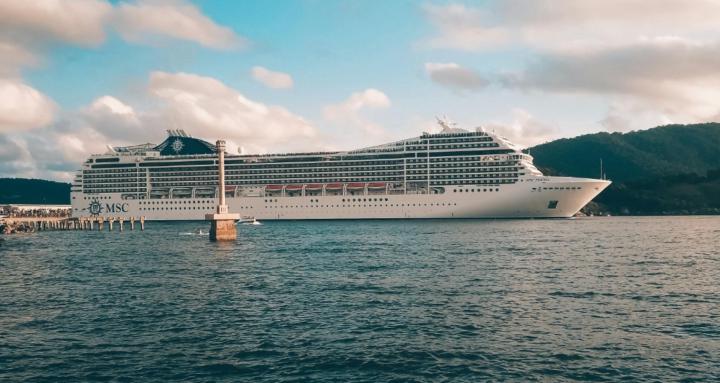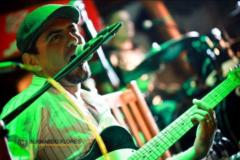17d (edited) • General discussion
Safety concepts (cont.)
Hello again everyone!
I'm writing to you today from somewhere over the North Atlantic just off Greenland where we were yesterday and which was the last port in Europe (although, geographically, Greenland is part of North America but it's generally tied to Europe) out of my 6 months tour on the Brilliance of the Seas, It's been lots of fun visiting many cities in Spain, Italy, Greece, Turkey, England, Scotland, Iceland and Greenland. We are heading back to America now where we'll be doing Canada and Northern USA ports mostly for the rest of my contract which will end in October. This is the kind of adventure you can look forward to by getting a cruise musician contract so, keep working on your material, and don't get discouraged if it takes some time for you to land your first contact, because once you get it, as long as you do your job well, you'll get another and another until you decide it's been enough sailing for one life time hahaha.
Any way I wanted to post some more information about safety onboard because is stuff you will get bombarded with when you get onboard. There's always a period of adjustment after getting on a ship even if is not for the first time, every ship has a different lay out, it takes time to get to know your way around, and on top of that, for first timers there's all this safety trainings with lots of information about things that you're expected to put into practice almost immediately, so it can be a little bit overwhelming, but how cool would it be if by the time you get on your first ship and on to your safety training you are already familiar with the concepts they'll be talking about! I'm sure it would lighten the burden a little. So, I'll give you a brief definition of some of the more important concepts and terminology you'll hear and use on a daily basis onboard.
Forward: The frontal part of the ship.
Aft: The back part of the ship.
Port side: Looking towards forward, is the left side of the ship.
Starboard side: looking towards forward, is the right side of the ship.
Deck: It's the equivalent of floor. For example; "The ship has 13 decks" means there's 13 floors or levels up and down the ship.
I 95: It's the main corridor of the crew area, it runs all through the shift on one deck, (usually deck number two) and gives access to every other area of the ship by use of stair cases or elevators.
Emergency card: It's a card you'll be issued that contains information about your safety duties.
Emergency number: A number that you are identified by for safety purposes, it's linked to your name and working position on the ship as well as your safety duties. Think about it; there's more than a dozen different nationalities and accents on board, not everybody will be able to pronounce or understand everyones name clearly and correctly, and in case of an emergency is vital that you can rely information clearly to the safety officers so they can act promptly and effectively, so it's easier to identify our selfs by this number.
Instruction number: This a number that specifies the duties of a certain group of crew members. There's a big board posted on several locations along the "I 95" which is called the "Crew Station Bill" crew members can consult this document to read the specific duties of their instruction number. For instance if your emergency card says that your instruction number is 23, that means that your job is to stand on a staircase location and guide the guests towards their "muster stations".
Emergency signal: It's an standard worldwide signal that is sounded by the ships's horn, so any one who hears it knows there's an emergency going on and they should procede to carry on their safety instructions and go to their designated emergency or muster stations.
The international emergency signal consists of 7 short and 1 long blasts from the ship's horn.
Emergency Station: This is the location of your post according to your instruction number, for the previous example we said that instruction 23 crew members stand on a staircase to guide guests, in this case your emergency station will surely be a staircase number (staircases are numbered so they can be easily located), for example: Emergency Station: Staircase 12, Deck 5, Starboard side. So that's where you should go in case of an emergency to carry on your duties.
Muster station: This is the location of the meeting point you are assigned to when it's time to get ready to board the life boats or life rafts in case you need to abandon ship.
International emergency code words:
This are words that the safety officers use to let the crew know there's a certain kind of emergency without actually saying wether there's a fire, or a bomb threat, or a man overboard, etc, because this announcements are made through the PA speakers all over the ship and guests could panic or try to "take some action" which could endanger the safety of them selves and/or the rest of the people onboard, so, these code words let us crew members know the specifics of an emergency without really alerting the guests:
ALFA: Medical emergency
BRAVO: Fire onboard (when a specific location is given)
BRAVO (without location): Collision, grounding or oil spill.
CHARLIE: Security threat. (Bomb threat, suspicious person or object, stowaway on board).
Oscar: Man overboard.
KILO: All crew to emergency stations.
I'll leave it at that at the moment. I hope you find this information, although maybe a bit boring, somewhat interesting as it is really important if you are to get onboard a ship to work. If you like this information, would like me to post some more of it or have any questions about it feel free to give my posts a thumbs up, follow me or hit me with your questions on a message. I'll be happy to respond. Alright then, carry on. See you next time!.
2
1 comment
powered by

skool.com/cruise-ships-for-musicians-1497
Cruise Ships for Musicians is a community dedicated to helping musicians break into the cruise industry.
Suggested communities
Powered by
